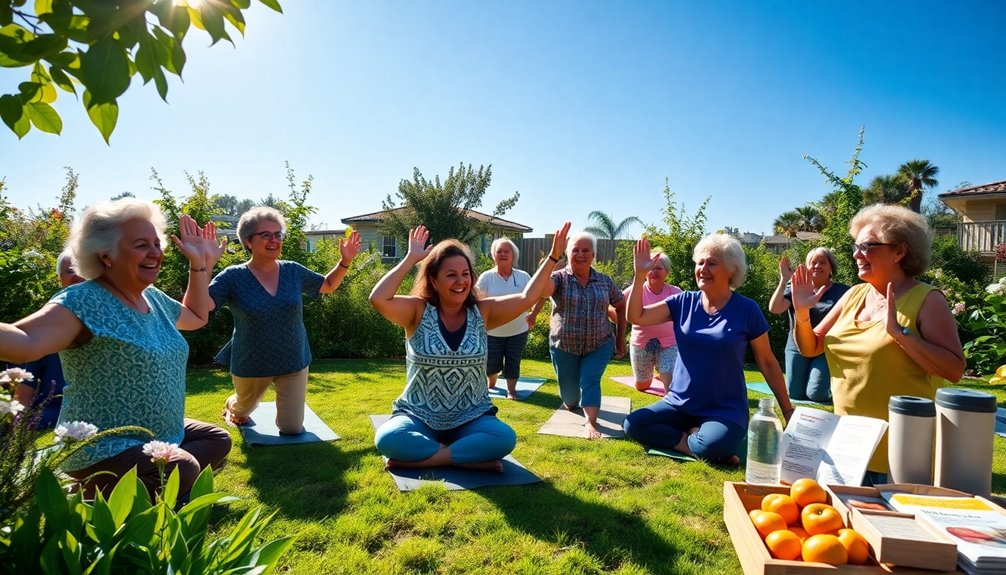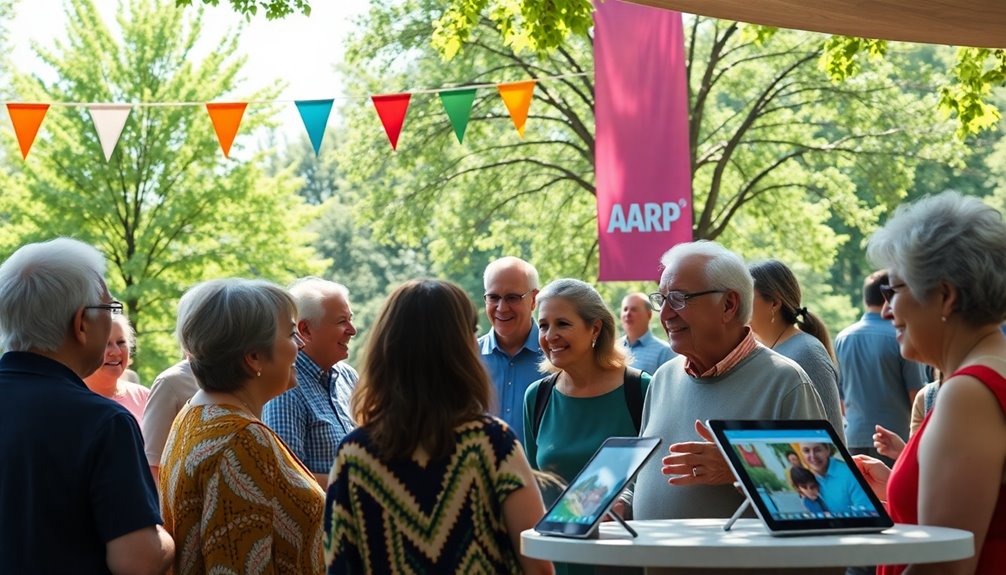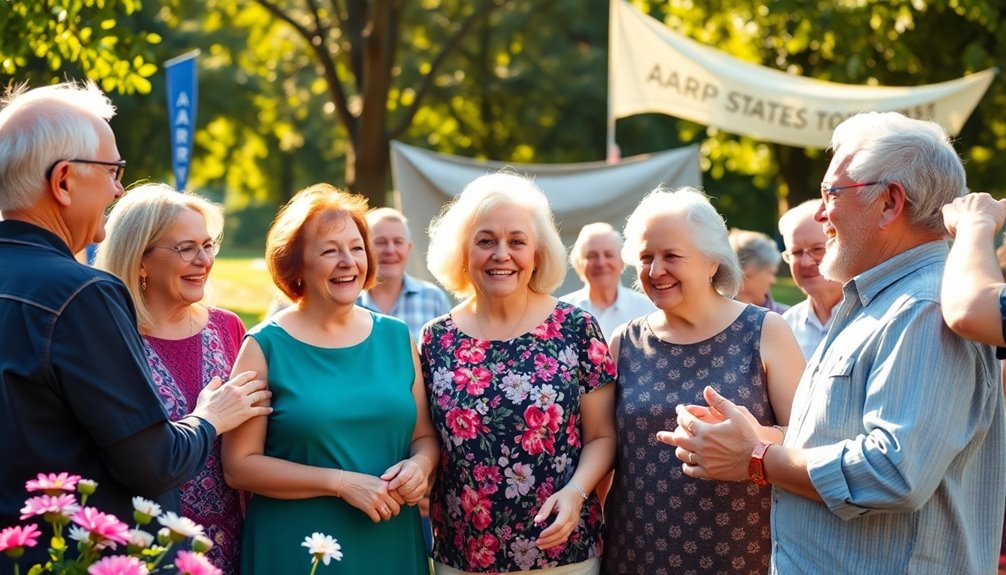AARPStates connects you with age-friendly communities across the nation. These communities promote independent living, access to services, and create social engagement opportunities. You'll find resources that support wellness, combat social isolation, and enhance digital literacy, making it easier for you to stay connected. AARP provides information on affordable housing, healthcare assistance, and community programs designed to help seniors thrive. As more folks age and the landscape changes, having a strong network becomes essential. If you explore further, you can discover how AARP is making a meaningful impact on the lives of seniors like you.
Key Takeaways
- AARP's Network of Age-Friendly States and Communities supports independent living through accessible housing and public infrastructure for seniors nationwide.
- Senior services provide essential support systems, including health initiatives and financial assistance programs like SNAP and Medicare across various states.
- Community engagement programs aim to reduce social isolation among older adults by promoting participation in local events and volunteer opportunities.
- Digital literacy initiatives, like those offered by AARP and OATS, empower seniors with essential tech skills for better connectivity and engagement.
- The National Plan on Aging encourages collaboration across sectors to address the diverse needs of the growing older adult population in the U.S.
Age-Friendly Communities Overview

Age-friendly communities are designed with you in mind, guaranteeing that every aspect of your neighborhood supports a fulfilling and independent lifestyle as you age. You'll find well-maintained and well-lit sidewalks, making it easier for you to navigate your surroundings safely. Public buildings are fully accessible, featuring automatic door openers and elevators that cater to your needs.
Clean, secure, and accessible public toilets are scattered throughout the area, along with public benches conveniently located for you to rest. Housing options are affordable, safe, and designed to integrate seamlessly into the community, allowing you to feel at home. These communities encourage your participation in local activities, whether it's visiting museums, taking courses, or volunteering. You'll have opportunities to engage in volunteer work, political roles, or even part-time employment. Safety and respect are paramount, fostering strong relationships within the community. Additionally, maintaining good health is vital, and living in an area with access to air purification technology can significantly improve your indoor air quality.
Accessible and affordable public transportation guarantees you can reach essential services and recreational facilities nearby. Parks and recreational areas are well-maintained and within easy access, providing you with opportunities for relaxation and socialization. In an age-friendly community, you're empowered to thrive and connect with others around you. This initiative emphasizes the importance of community support to ensure that health services and social networks are easily accessible to all seniors.
Senior Services and Support Systems

Maneuvering through the complexities of aging can be intimidating, but a robust network of senior services and support systems is here to help you thrive. States like Minnesota, Washington, and the District of Columbia lead the way in long-term care support, especially for family caregivers. However, the long-term care system is still recovering from the impacts of the COVID-19 pandemic, facing increased costs and a shortage of quality direct care workers. The recent AARP's LTSS Scorecard highlights persistent gaps in care across all 50 states, underscoring the need for continued improvement. Additionally, understanding the benefits of merchant account credit processing can help seniors manage their finances more effectively.
Financial assistance programs, such as those offered by the AARP Foundation, help you access essential benefits like SNAP and Medicare Savings Programs, providing significant savings on healthcare costs. In 2023 alone, these initiatives helped over 52,000 older adults secure $105 million in benefits.
Health and wellness programs also play a key role in your well-being. Organizations like Senior Planet offer exercise classes and telemedicine resources, empowering you to manage your health effectively. Additionally, social engagement initiatives aim to reduce isolation by connecting you with your community, whether through virtual platforms or in-person gatherings. By leveraging these services, you can enhance your quality of life and embrace the aging process with confidence.
Enhancing Digital Literacy

In today’s digital world, gaining tech skills is essential for seniors to stay connected and engaged. AARP has teamed up with Older Adults Technology Services (OATS) to enhance digital literacy through a variety of free courses available nationwide. This initiative focuses on bridging the digital divide and empowering older adults with the skills they need. These courses cover a range of topics, from basic computer skills to social media navigation, ensuring that seniors can engage with family and friends online. By connecting with seniors via language, instructors tailor their teaching methods to meet the unique learning styles and needs of older learners. This personalized approach not only fosters confidence in using technology but also encourages seniors to embrace the digital landscape, enhancing their overall quality of life.
Here are three key components of the program:
- Comprehensive Curriculum: You'll learn essential skills like online safety, using Zoom, and managing your emails. Classes also cover social media, online banking, and even creative tools like Canva. Additionally, understanding email security insights will help you recognize and avoid potential online threats.
- Accessibility: Classes are designed to be inclusive, offering multilingual support and resources for seniors in rural and diverse communities. You can join sessions either in-person or online, ensuring you can participate comfortably. Additionally, the program is committed to offering courses for Spanish speakers to further enhance accessibility.
- Community Engagement: AARP collaborates with local organizations to deliver classes and enhance outreach. With initiatives like the Digital Skills Ready@50+, the program aims to train thousands of seniors, focusing on those from low-income backgrounds.
Combating Social Isolation

Social isolation is a pressing issue that many seniors face, and it is crucial to address it head-on. In 2023, 37% of older adults aged 50-80 reported feeling lonely, with 34% feeling socially isolated. The consequences are profound, impacting both mental and physical health. You might find that factors like poor health, living alone, or loss of a loved one increase your risk of social isolation. Research indicates that increased social isolation generally raises the risk of loneliness, making it essential to seek connections. Engaging in mindfulness techniques can also help reduce feelings of loneliness and promote emotional resilience.
To combat this issue, consider the following interventions:
| Intervention | Benefits |
|---|---|
| Maintain daily interactions | Enhances emotional well-being |
| Participate in local events | Fosters community connections |
| Engage in online groups | Provides social interaction from home |
| Join group exercise classes | Boosts physical health and social ties |
| Volunteer with local organizations | Creates purpose and builds friendships |
Staying connected is critical, so don't hesitate to reach out to family and friends. Engaging in community activities and support groups can greatly reduce feelings of isolation. By taking these steps, you can improve your overall well-being and enjoy a more fulfilling life.
Health and Wellness Initiatives

As the landscape of health care evolves, it's essential for seniors to engage with health and wellness initiatives that cater to their unique needs. Accessing quality care can be challenging, but integrated care models and community-based approaches are making a difference. Programs like Australia's Health Care Home prioritize centralized care, ensuring your health records are seamlessly managed through technology. Universal health care coverage has been achieved in many countries, enhancing access for seniors. Additionally, maintaining adequate sleep is crucial for recovery and overall health, which can significantly impact seniors' well-being.
Here are three key health and wellness initiatives you can explore:
- Wellness Programs and Incentives: AARP Medicare Supplement Insurance Plans offer extras like gym memberships and fitness programs. You can also find discounts on dental, vision, and hearing services.
- Community Engagement: Participate in local community programs like Singapore's Community for Successful Ageing, which promotes a person-centered approach to care. These initiatives focus on maintaining quality of life and promoting social interaction. Regular physical activity is also encouraged to enhance cardiovascular health within these community settings.
- Dementia-Friendly Initiatives: Engage in local dementia-friendly projects, such as specialized supermarkets and outdoor activity programs, designed to support those living with dementia and their caregivers.
Demographic Trends and Implications

With an aging population rapidly transforming the demographic landscape, understanding the implications of these trends is essential for seniors and policymakers alike. Every day, 10,000 people in the U.S. turn 65, contributing to a projected doubling of older adults to over 88 million by 2050. By then, seniors will comprise more than 20% of the population, which raises critical considerations for labor force participation and social support.
Despite facing challenges, older Americans are increasingly active in the labor market, with participation rates expected to reach 21.7% by 2024. This shift reflects a desire to remain engaged and financially secure. However, as many baby boomers age, they may find themselves lacking family support due to changing social dynamics, such as declining marriage rates and increased divorce. Additionally, the demand for home health care services has surged as the aging population seeks to maintain their independence. Advance directives can further assist seniors in making informed decisions about their care preferences.
Social isolation and rising healthcare costs pose significant challenges for older adults. Affordable housing and transportation options are crucial for fostering connections and reducing loneliness. As these demographic trends unfold, both seniors and policymakers must address the pressing needs and opportunities that arise, ensuring that the aging population can thrive in a supportive and connected environment.
Future of AARP Connections

The future of AARP connections looks promising as communities across the nation embrace age-friendly initiatives. With over 887 communities joining the AARP Network of Age-Friendly States and Communities, the impact is profound. These efforts focus on enhancing quality of life for all ages through policy changes and increased collaboration.
Here are three key areas where AARP connections will evolve:
- Housing Innovations: Expect more creative housing options, including modular homes and multigenerational developments, enabling older adults to age in place comfortably while fostering community ties. This aligns with the focus on affordable housing options for seniors. Additionally, proper dental care can enhance the overall well-being of seniors, similar to the care provided for miniature horses.
- Health and Well-Being: AARP emphasizes the importance of social connections, which play an essential role in health. Future initiatives will provide resources to help you maintain and expand your social circles, combating isolation.
- National Plan on Aging: The ongoing national plan aims to support older Americans through multisector collaboration, focusing on healthy living and family caregiver support. Listening sessions will guarantee that your voices shape the future of aging policies.
As these initiatives unfold, AARP connections will continue to strengthen, creating vibrant, inclusive communities that support aging with dignity and purpose.
Frequently Asked Questions
How Can I Join the AARP Network of Age-Friendly Communities?
If you want to join the AARP Network of Age-Friendly Communities, start by submitting a membership application. Gather a signed letter of commitment from your highest elected official and, if needed, pass a supportive resolution. Conduct a community needs assessment and develop an action plan that AARP must approve. Collaborate with local leaders, implement your plan, and continuously evaluate your progress. It's a chance to create a more inclusive, supportive environment for everyone.
What Resources Are Available for Caregivers Through AARP?
If you're a caregiver, AARP offers a wealth of resources to support you. You can access state-specific guides that connect you to local programs and services, including health, legal, and financial assistance. They provide coping strategies for managing stress, tips for bonding with grandchildren, and even a caregiver resource line for confidential support. Plus, you'll find advocacy efforts dedicated to improving caregiving policies that could save you time and money.
Are There Membership Fees for AARP Programs and Services?
Imagine accessing a treasure trove of benefits for just $16 a year. That's the standard fee for AARP membership, but if you opt for auto-renewal, you can snag your first year for only $12! If you're planning to stick around, consider the three-year plan at $43 or the five-year plan at $63 for even bigger savings. You'll enjoy discounts, advocacy, and a free membership for your spouse or partner, too!
How Does AARP Advocate for Older Adults' Rights?
AARP advocates for older adults' rights by influencing public policy and legislation that impacts your life. They mobilize members like you to take action on key issues such as healthcare access and financial security. Their team of lobbyists works directly with lawmakers, while legal advocacy combats age discrimination and nursing home abuses. AARP also offers resources that empower you to navigate complex issues and connects you with social services for additional support.
Can I Volunteer With AARP to Support Senior Initiatives?
Imagine a bridge built from compassion, connecting you to seniors in need. Yes, you can volunteer with AARP to support essential initiatives for older adults. Whether you're delivering meals, tutoring children, or helping with tax preparation, you'll make a real difference. You'll receive training and ongoing support, ensuring you feel confident in your role. By volunteering, you not only enrich lives but also create a stronger, more connected community for everyone.








